Abstract
Previous studies show that cytotoxic activated macrophages cause inhibition of DNA synthesis, inhibition of mitochondrial respiration, and loss of intracellular iron from tumor cells. Here we examine aconitase, a citric acid cycle enzyme with a catalytically active iron-sulfur cluster, to determine if iron-sulfur clusters are targets for activated macrophage-induced iron removal. Results show that aconitase activity declines dramatically in target cells after 4 h of co-cultivation with activated macrophages. Aconitase inhibition occurs simultaneously with arrest of DNA synthesis, another early activated macrophage-induced metabolic change in target cells. Dithionite partially prevents activated macrophage induced aconitase inhibition. Furthermore, incubation of injured target cells in medium supplemented with ferrous ion plus a reducing agent causes near-complete reconstitution of aconitase activity. The results show that removal of a labile iron atom from the [4Fe-4S] cluster, by a cytotoxic activated macrophage-mediated mechanism, is causally related to aconitase inhibition.
Full text
PDF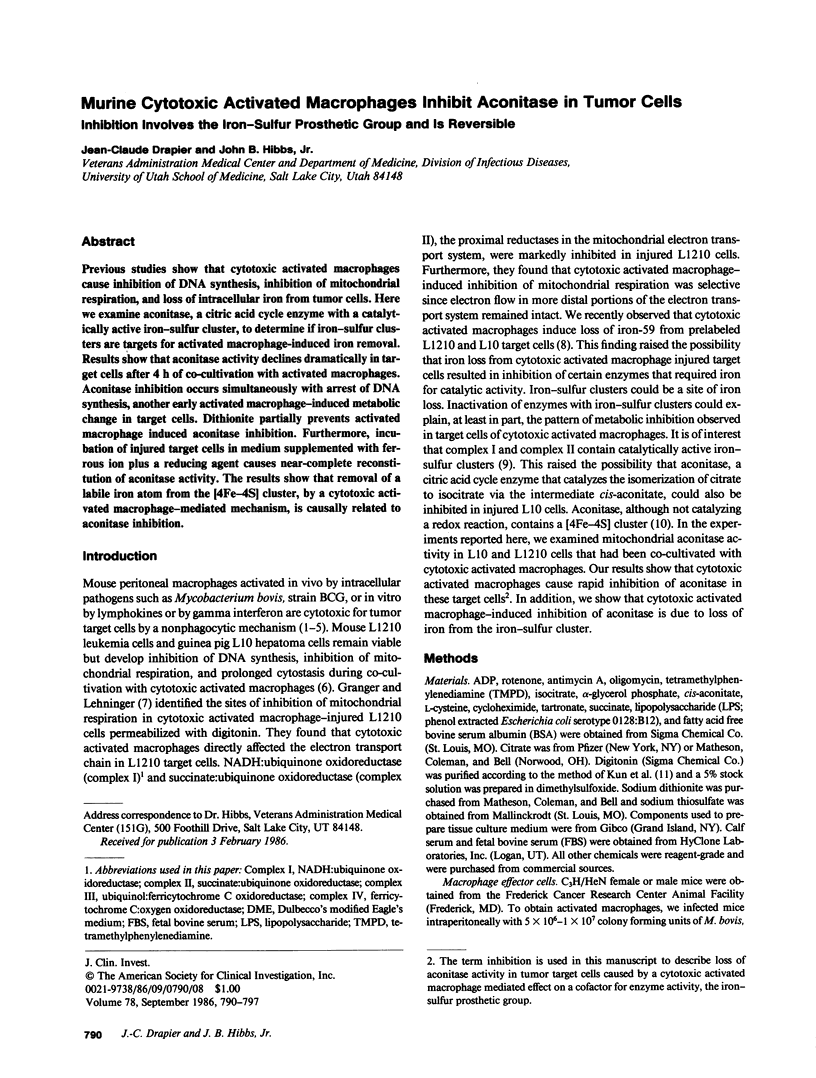
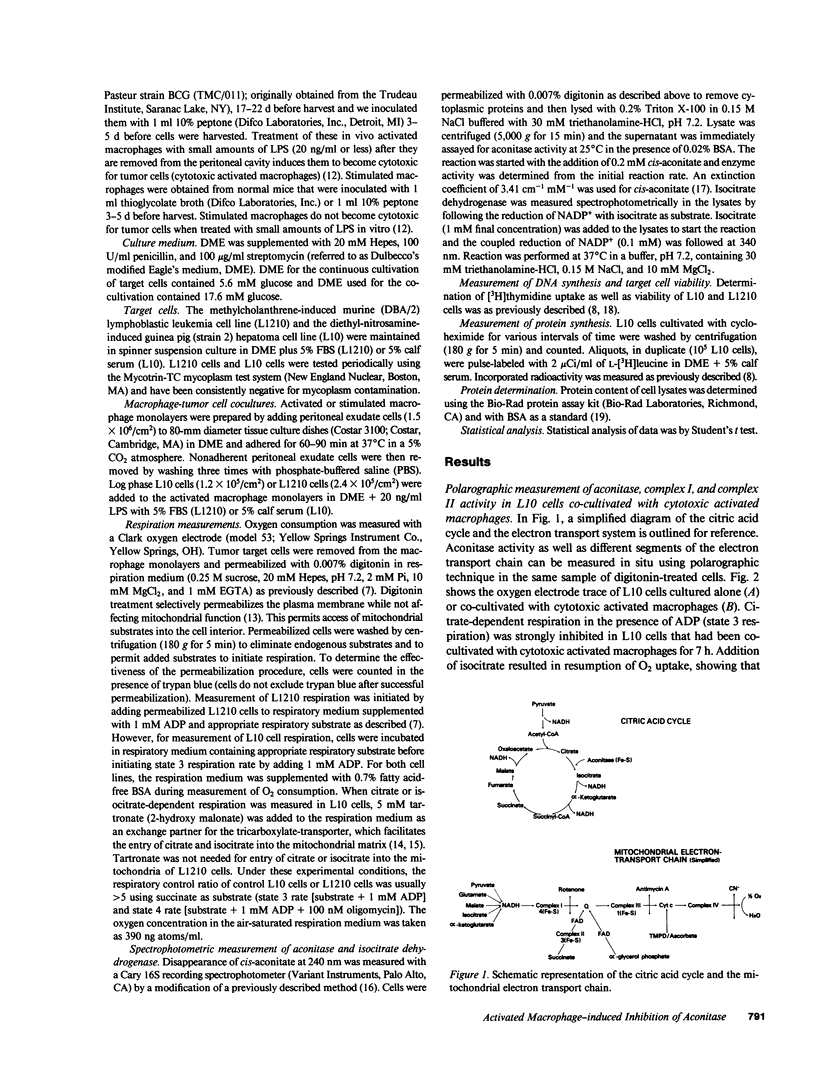
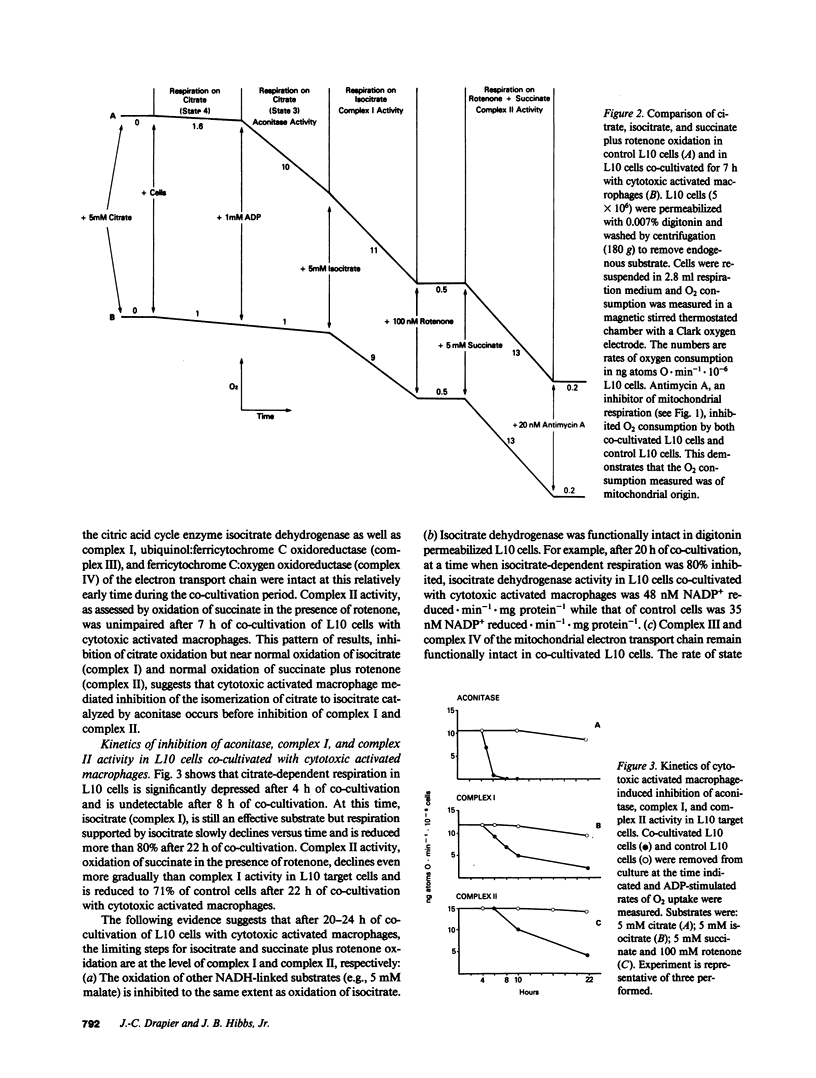
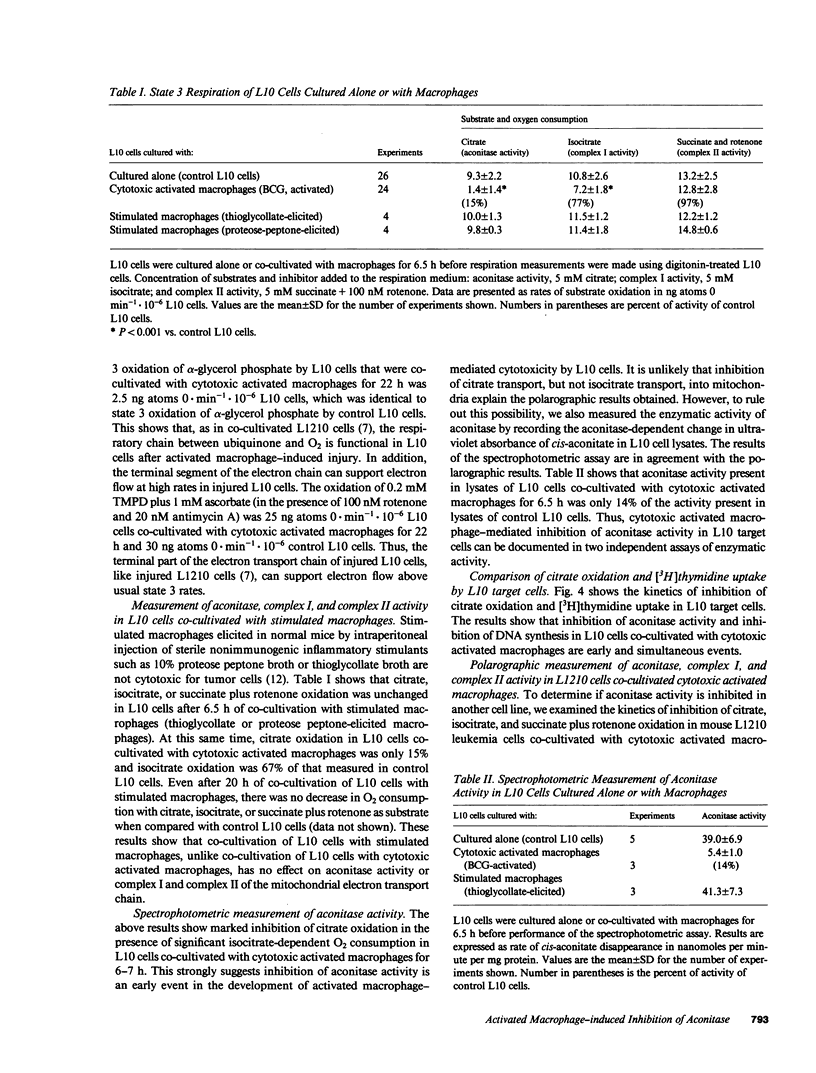

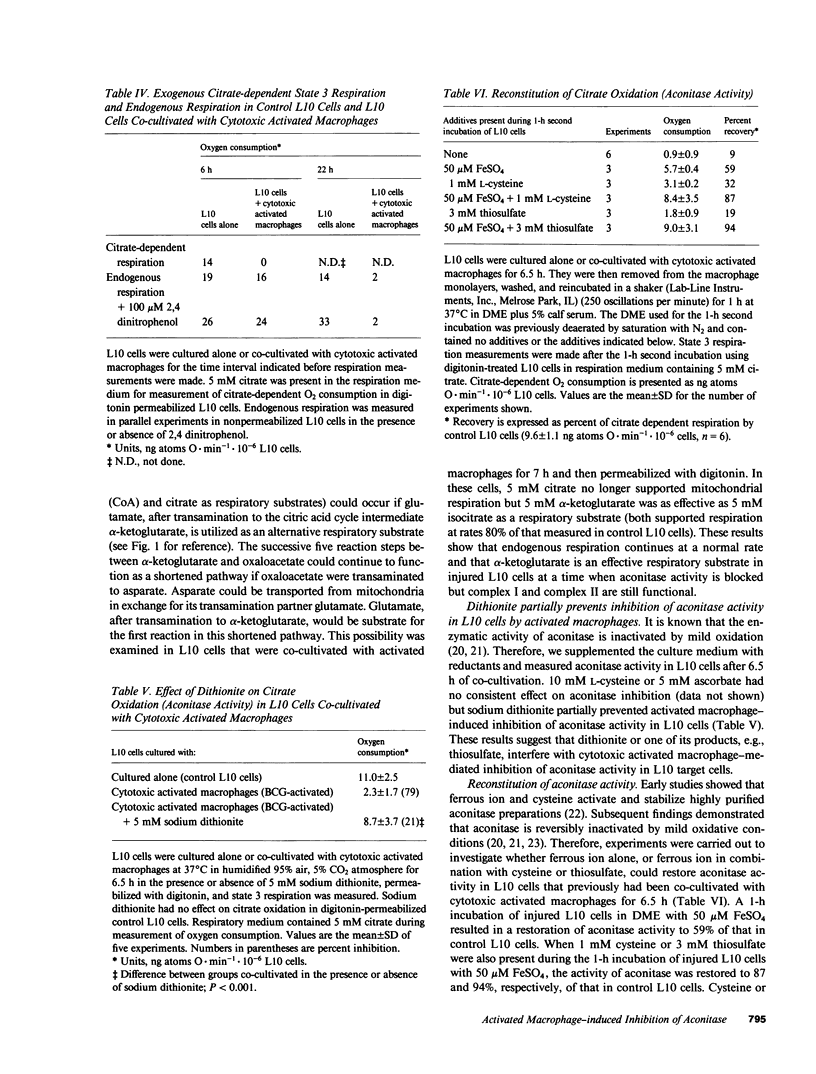
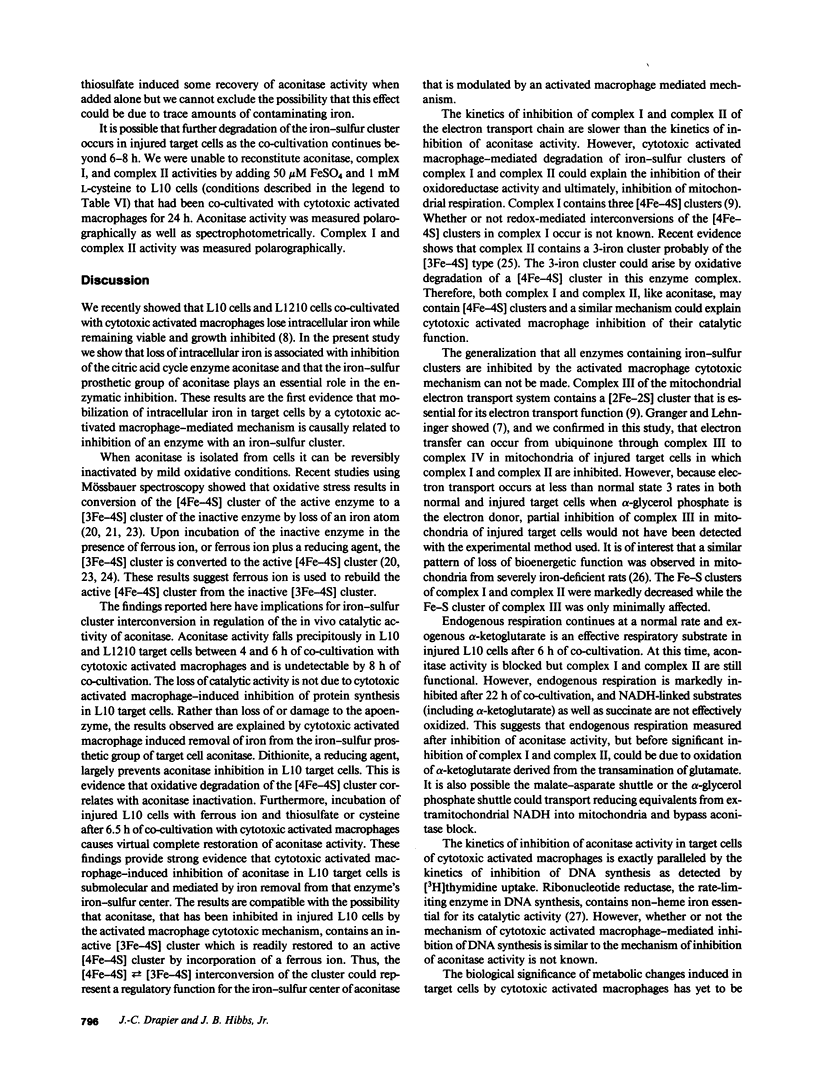
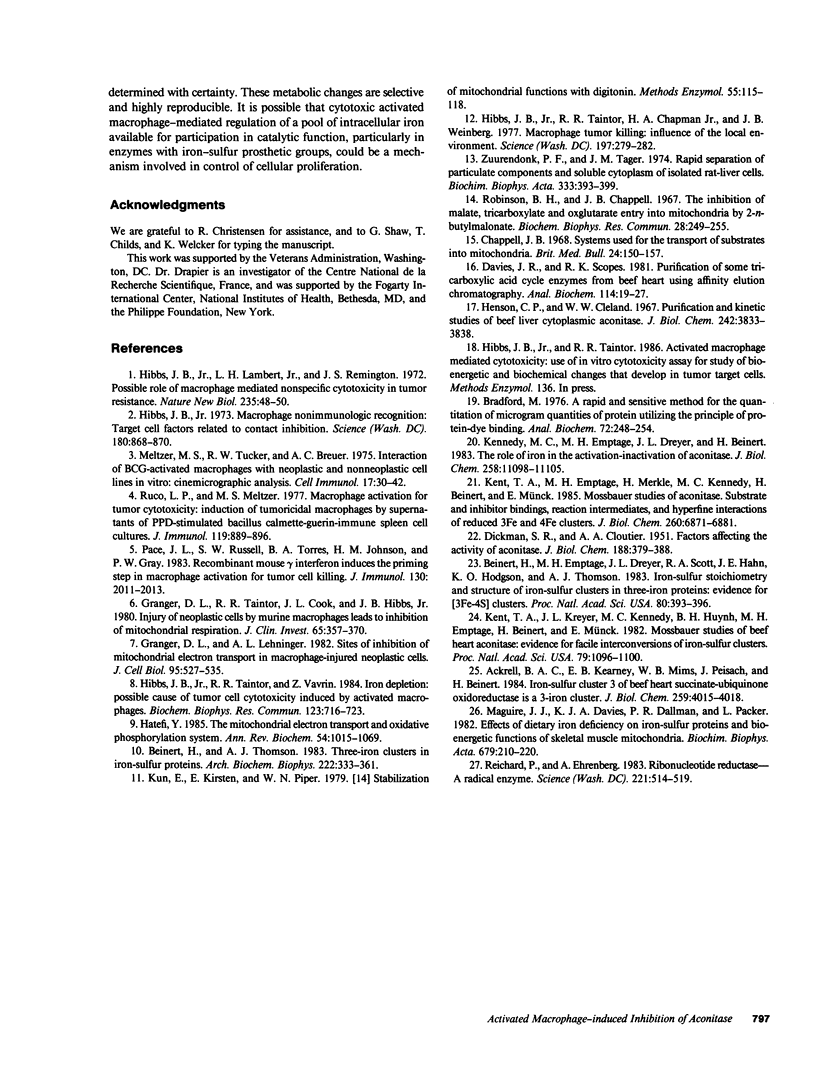
Selected References
These references are in PubMed. This may not be the complete list of references from this article.
- Ackrell B. A., Kearney E. B., Mims W. B., Peisach J., Beinert H. Iron-sulfur cluster 3 of beef heart succinate-ubiquinone oxidoreductase is a 3-iron cluster. J Biol Chem. 1984 Apr 10;259(7):4015–4018. [PubMed] [Google Scholar]
- Beinert H., Emptage M. H., Dreyer J. L., Scott R. A., Hahn J. E., Hodgson K. O., Thomson A. J. Iron-sulfur stoichiometry and structure of iron-sulfur clusters in three-iron proteins: evidence for [3Fe-4S] clusters. Proc Natl Acad Sci U S A. 1983 Jan;80(2):393–396. doi: 10.1073/pnas.80.2.393. [DOI] [PMC free article] [PubMed] [Google Scholar]
- Beinert H., Thomson A. J. Three-iron clusters in iron-sulfur proteins. Arch Biochem Biophys. 1983 Apr 15;222(2):333–361. doi: 10.1016/0003-9861(83)90531-3. [DOI] [PubMed] [Google Scholar]
- Bradford M. M. A rapid and sensitive method for the quantitation of microgram quantities of protein utilizing the principle of protein-dye binding. Anal Biochem. 1976 May 7;72:248–254. doi: 10.1016/0003-2697(76)90527-3. [DOI] [PubMed] [Google Scholar]
- Chappell J. B. Systems used for the transport of substrates into mitochondria. Br Med Bull. 1968 May;24(2):150–157. doi: 10.1093/oxfordjournals.bmb.a070618. [DOI] [PubMed] [Google Scholar]
- DICKMAN S. R., CLOUTIER A. A. Factors affecting the activity of aconitase. J Biol Chem. 1951 Jan;188(1):379–388. [PubMed] [Google Scholar]
- Davies J. R., Scopes R. K. Purification of some tricarboxylic acid cycle enzymes from beef heart using affinity elution chromatography. Anal Biochem. 1981 Jun;114(1):19–27. doi: 10.1016/0003-2697(81)90444-9. [DOI] [PubMed] [Google Scholar]
- Granger D. L., Lehninger A. L. Sites of inhibition of mitochondrial electron transport in macrophage-injured neoplastic cells. J Cell Biol. 1982 Nov;95(2 Pt 1):527–535. doi: 10.1083/jcb.95.2.527. [DOI] [PMC free article] [PubMed] [Google Scholar]
- Granger D. L., Taintor R. R., Cook J. L., Hibbs J. B., Jr Injury of neoplastic cells by murine macrophages leads to inhibition of mitochondrial respiration. J Clin Invest. 1980 Feb;65(2):357–370. doi: 10.1172/JCI109679. [DOI] [PMC free article] [PubMed] [Google Scholar]
- Hatefi Y. The mitochondrial electron transport and oxidative phosphorylation system. Annu Rev Biochem. 1985;54:1015–1069. doi: 10.1146/annurev.bi.54.070185.005055. [DOI] [PubMed] [Google Scholar]
- Henson C. P., Cleland W. W. Purification and kinetic studies of beef liver cytoplasmic aconitase. J Biol Chem. 1967 Sep 10;242(17):3833–3838. [PubMed] [Google Scholar]
- Hibbs J. B., Jr, Lambert L. H., Jr, Remington J. S. Possible role of macrophage mediated nonspecific cytotoxicity in tumour resistance. Nat New Biol. 1972 Jan 12;235(54):48–50. doi: 10.1038/newbio235048a0. [DOI] [PubMed] [Google Scholar]
- Hibbs J. B., Jr Macrophage nonimmunologic recognition: target cell factors related to contact inhibition. Science. 1973 May 25;180(4088):868–870. doi: 10.1126/science.180.4088.868. [DOI] [PubMed] [Google Scholar]
- Hibbs J. B., Jr, Taintor R. R., Chapman H. A., Jr, Weinberg J. B. Macrophage tumor killing: influence of the local environment. Science. 1977 Jul 15;197(4300):279–282. doi: 10.1126/science.327547. [DOI] [PubMed] [Google Scholar]
- Hibbs J. B., Jr, Taintor R. R., Vavrin Z. Iron depletion: possible cause of tumor cell cytotoxicity induced by activated macrophages. Biochem Biophys Res Commun. 1984 Sep 17;123(2):716–723. doi: 10.1016/0006-291x(84)90288-2. [DOI] [PubMed] [Google Scholar]
- Kennedy M. C., Emptage M. H., Dreyer J. L., Beinert H. The role of iron in the activation-inactivation of aconitase. J Biol Chem. 1983 Sep 25;258(18):11098–11105. [PubMed] [Google Scholar]
- Kent T. A., Dreyer J. L., Kennedy M. C., Huynh B. H., Emptage M. H., Beinert H., Münck E. Mössbauer studies of beef heart aconitase: evidence for facile interconversions of iron-sulfur clusters. Proc Natl Acad Sci U S A. 1982 Feb;79(4):1096–1100. doi: 10.1073/pnas.79.4.1096. [DOI] [PMC free article] [PubMed] [Google Scholar]
- Kent T. A., Emptage M. H., Merkle H., Kennedy M. C., Beinert H., Münck E. Mössbauer studies of aconitase. Substrate and inhibitor binding, reaction intermediates, and hyperfine interactions of reduced 3Fe and 4Fe clusters. J Biol Chem. 1985 Jun 10;260(11):6871–6881. [PubMed] [Google Scholar]
- Kun E., Kirsten E., Piper W. N. Stabilization of mitochondrial functions with digitonin. Methods Enzymol. 1979;55:115–118. doi: 10.1016/0076-6879(79)55016-2. [DOI] [PubMed] [Google Scholar]
- Maguire J. J., Davies K. J., Dallman P. R., Packer L. Effects of dietary iron deficiency of iron-sulfur proteins and bioenergetic functions of skeletal muscle mitochondria. Biochim Biophys Acta. 1982 Feb 17;679(2):210–220. doi: 10.1016/0005-2728(82)90292-4. [DOI] [PubMed] [Google Scholar]
- Meltzer M. S., Tucker R. W., Breuer A. C. Interaction of BCG-activated macrophages with neoplastic and noneoplastic cell lines in vitro: cinemicrographic analysis. Cell Immunol. 1975 May;17(1):30–42. doi: 10.1016/s0008-8749(75)80004-9. [DOI] [PubMed] [Google Scholar]
- Pace J. L., Russell S. W., Torres B. A., Johnson H. M., Gray P. W. Recombinant mouse gamma interferon induces the priming step in macrophage activation for tumor cell killing. J Immunol. 1983 May;130(5):2011–2013. [PubMed] [Google Scholar]
- Reichard P., Ehrenberg A. Ribonucleotide reductase--a radical enzyme. Science. 1983 Aug 5;221(4610):514–519. doi: 10.1126/science.6306767. [DOI] [PubMed] [Google Scholar]
- Robinson B. H., Chappell J. B. The inhibition of malate, tricarboxylate and oxoglutarate entry into mitochondria by 2-n-butylmalonate. Biochem Biophys Res Commun. 1967 Jul 21;28(2):249–255. doi: 10.1016/0006-291x(67)90437-8. [DOI] [PubMed] [Google Scholar]
- Ruco L. P., Meltzer M. S. Macrophage activation for tumor cytotoxicity: induction of tumoricidal macrophages by supernatants of PPD-stimulated Bacillus Calmette-Guérin-immune spleen cell cultures. J Immunol. 1977 Sep;119(3):889–896. [PubMed] [Google Scholar]


